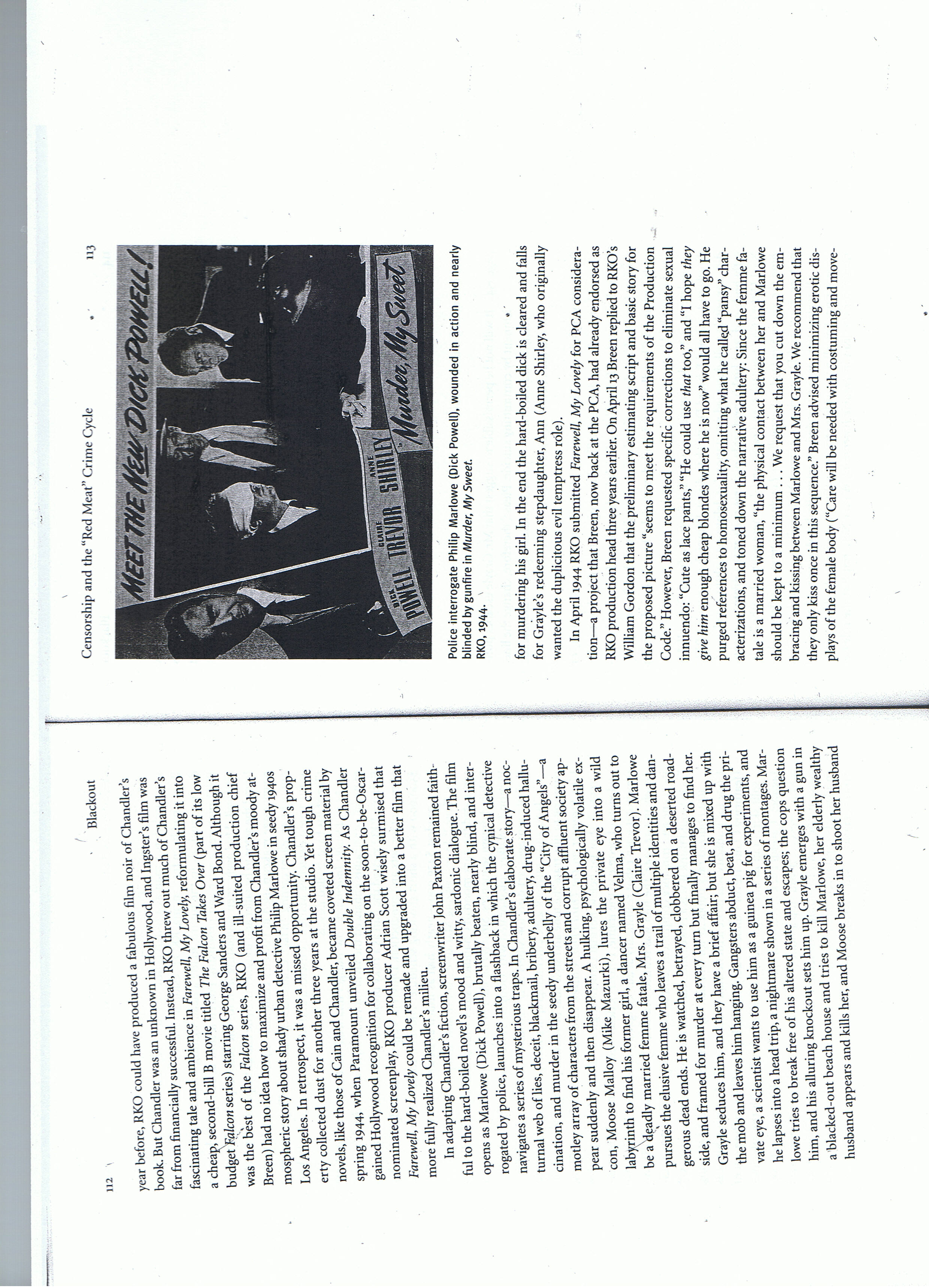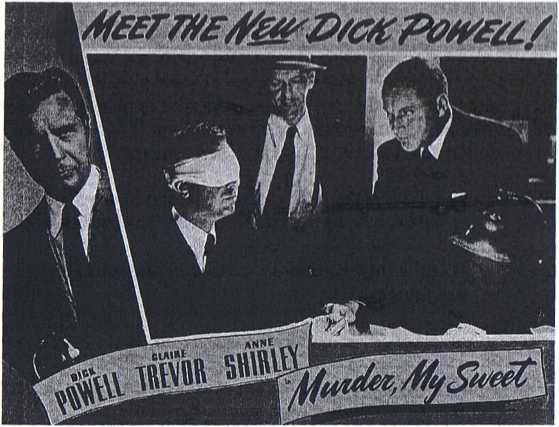censorship, (8)

112 t
Blackout
year before, RKO could have produced a fabulous film noir of Chandler’s book. But Chandler was an unknown in Hollywood, and Ingster’s film was far from financially successful. Instead, RKO threw out much of Chandler’s fascinating tale and ambience in Farewell, My Lovely, reformulating it into a cheap, second-bill B movie titled The Falcon Takes Over (part of its Iow budget Ffl/con series) starring George Sanders and Ward Bond. Although it was the best of the Falcon series, RKO (and ill-suited production chief Breen) had no idea how to maximize and profit from Chandler’s moody at-mospheric story about shady urban detective Philip Marlowe in seedy 1940S Los Angeles. In retrospect, it was a missed opportunity. Chandler’s prop-erty collected dust for another three years at the studio. Yet tough crime novels, like those of Cain and Chandler, became coveted screen materiał by spring 1944, when Paramount unveiled Double Indemnity. As Chandler gained Hollywood recognition for collaborating on the soon-to-be-Oscar-nominated screenplay, RKO producer Adrian Scott wisely surmised that Farewell, My Lovely could be remade and upgraded into a better film that morę fully realized Chandler’s milieu.
In adapting Chandlers fiction,screenwriter John Paxton remained faith-ful to the hard-boiled novel’s mood and witty, sardonic dialogue. The film opens as Marlowe (Dick Powell), brutally beaten, nearly blind, and inter-rogated by police, launches into a flashback in which the cynical detective navigates a series of mysterious traps. In Chandler’s elaborate story—a noc-turnal web of lies, deceit, blackmail, bribery, adultery, drug-induced hallu-cination, and murder in the seedy underbelly of the “City of Angels”—a motley array of characters from the streets and corrupt affluent society ap-pear suddenly and then disappear. A hulking, psychologically volatile ex-con, Moose Malloy (Mikę Mazurki), lures the private eye into a wild labyrinth to find his former girl, a dancer named Velma, who turns out to be a aęadly married femme fatale, Mrs. Grayle (Claire Trevor). Marlowe pursues the elusive femme who leaves a trail of multiple identities and dan-gerous dead ends. He is watched, betrayed, clobbered on a deserted road-side, and ff amed for murder at every turn but finally manages to find her. Grayle seduces him, and they have a brief affair; but she is mixed up with the mob and leaves him hanging. Gangsters abduct, beat, and drug the pri-vate eye, a scientist wants to use him as a guinea pig for experiments, and he lapses into a head trip, a nightmare shown in a series of montages. Marlowe tries to break free of his altered State and escapes; the cops ąuestion him, and his alluring knockout sets him up. Grayle emerges with a gun in a blacked-out beach house and tries to kill Marlowe, her elderly wealthy husband appears and kills her, and Moose breaks in to shoot her husband

Police interrogate Philip Marlowe (Dick Powell), wounded in action and nearly blinded by gunfire in Murder, My Sweet.
RKO, 1944. '
for murdering his girl. In the end the hard-boiled dick is cleared and falls for Grayle’s redeeming stepdaughter, Ann (Annę Shirley, who originally wanted the duplicitous evil temptress role).
In April 1944 RKO submitted Farewell, My Lovely for PCA considera-tion—a project that Breen, now back at the PCA, had already endorsed as RKO production head three years earlier. On April 13 Breen replied to RKO’s William Gordon that the preliminary estimating script and basie story for the proposed picture “seems to meet the reąuirements of the Production Codę.” However, Breen reąuested specific corrections to eliminate sexual innuendo: “Cute as lace pants,” “He could use that toó,” and “I hope they give him enough cheap blondes where he is now” would all have to go. He purged references to homosexuality, omitting what he called “pansy” char-acterizations, and toned down the narrative adultery: Since the femme fa-tale is a married woman, “the physical contact between her and Marlowe should be kept to a minimum ... We reąuest that you cut down the em-bracing and kissing between Marlowe and Mrs. Grayle. We recommend that they only kiss once in this sequence.” Breen advised minimizing erotic dis-plays of the female body (“Care will be needed with costuming and move-
Wyszukiwarka
Podobne podstrony:
221 (29) Bibliography We have INCLUDED not only the works that we have used in the making of this bo
Discussion of grades on assignments must take place before two weeks have elapsed from the receipt o
censorship, (4) 104 Blackout York Times heralded “U.S. Renews Battle on Film Monopolies” by Augus
14. In the last hundred years or so people have anticipated the imminent death of the book a few tim
LoseItJan2015 ‘I LOST 32KG IN ONE YEAR!’ I before BEST- sęuing BflNTING MAG!The LCHF/ban1
LoseItJan2015 ‘I LOST 32KG IN ONE YEAR!’ I before BEST- sęuing BflNTING MAG!The LCHF/ban1
66 A. Kaniecki the cleaning-out of a river bed to enable the work of water mills, could have the con
BS page01 Must-have designs for every week of the year! you can make!Beacf^ SPECIA
ćw might, should, cold etc You could have helped me! (Why didrit you?) You might have let me knowyo
LoseItJan2015 ‘I LOST 32KG IN ONE YEAR!’ I before BEST- sęuing BflNTING MAG!The LCHF/ban1
15 Re-shaping the Global Financial Architecture: Dual SIFIs Role failure could have economically si
Watashitachi no Shiawasena Jikan?8#7 Perhaps I could have said ło you łhe words that I could never s
essent?rving?04 E S S E N T I A L W O O D C A R V I N G T E C H N I Q V E S (Fig 9.20) bur could hav
348 (30) 321Pendants This category covers a diverse rangę of items, some of which coułd have stood a
censorship, (18) Blackout 132 wcrc both spicy and economical. Rita Hayworth’s seductive attire in
censorship, (1) 98 Blackout cious insurance claims investigator Barton Kęyes (Edward G. Robinson)
censorship, (2) 100 Blackout interested. According to Cain, after Breen rejected MGM’s 1935 submi
censorship, (3) 102 Blackout Pierce which I am told has favorable Hays comment? What about Serena
więcej podobnych podstron